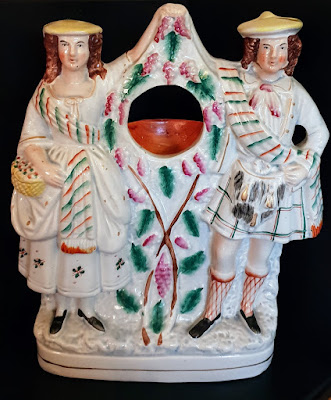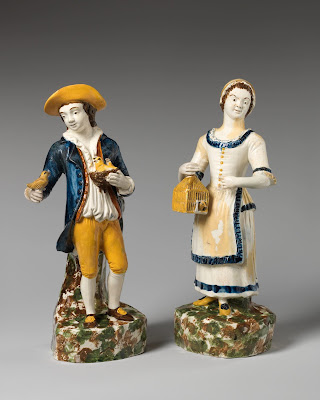In a deeply religious age,
the Bible provided plenty of subjects for pottery figure makers … this is
derived from the Old Testament Book of Kings Chapter 17: Verses 7-16, King James Version … 7 And it came to
pass after a while, that the brook dried up, because there had been no rain in
the land. 8 And the word of
the Lord came unto him, saying,
9 Arise, get thee to Zarephath, which belongeth to Zidon, and dwell
there: behold, I have commanded a widow woman there to sustain thee. 10 So
he arose and went to Zarephath. And when he came to the gate of the city,
behold, the widow woman was there gathering of sticks: and he calledto her,
and said, Fetch me, I pray thee, a little water in a vessel, that I may
drink. 11 And as she was going to
fetch it, he called to her, and said, Bring me, I pray thee, a morsel of bread
in thine hand. 12 And she said, As
the Lord thy God liveth, I have not a cake, but an handful of meal in
a barrel, and a little oil in a cruse: and, behold, I am gathering two sticks,
that I may go in and dress it for me and my son, that we may eat it, and die. 13 And Elijah said unto her, Fear not;
go and do as thou hast said: but make me thereof a little cake first, and bring
it unto me, and after make for thee and for thy son. 14 For thus saith the Lord God
of Israel, The barrel of meal shall not waste, neither shall the cruse of oil
fail, until the day that the Lord sendeth rain upon the earth. 15 And she went and did according to the
saying of Elijah: and she, and he, and her house, did eat many days. 16 And the barrel of meal wasted not,
neither did the cruse of oil fail, according to the word of the Lord,
which he spake by Elijah.
Of course, these stories
looked so much more impressive in the printing styles of olden times …
In 1827, a village named Polstead in Suffolk attracted worldwide attention. A young woman of rather ill repute named Maria Marten was shot dead by her lover William Corder, a local farmer’s son, whom she had planned to run away with and marry. Maria had already borne a child to William, and a couple more illegitimate children to different men. The two had arranged to meet at the Red Barn, a local landmark, before eloping to Ipswich. After that night, Maria was never seen again alive. Corder claimed that he was living with Maria, and he also sent letters to her family claiming that she was in good health. But Maria’s step-mother dreamed that Maria had been murdered and buried in the Red Barn. Her husband went to the Red Barn and dug up the floor, finding the badly decomposed body of his daughter. Corder, who was now married with a new wife, was later tracked down to London and arrested. He was sentenced and hanged. His execution was witnessed by more than 10,000 people.
Murders and public executions were big entertainment for Victorians. The Red Barn Murder found wide coverage in the media. The case was closely followed by newspapers, and books were published while the trial was still underway. Songs were written and the gruesome murder was re-enacted in plays. The fascination continued throughout the century and the next. The village where the crime had taken place became a tourist attraction and the barn was literally picked apart by souvenir hunters. Such huge public interest caused the Staffordshire potters to produce a number of Staffordshire models of The Red Barn.
The Red Barn figures contain three sets. The group on the left depicts the murderer and his victim. The middle group, shows William Corder standing by the open door of the barn, beckoning to Maria Marten to join him inside. The last group shows Corder standing before the judge. The figures are around 20 cm tall.

9
The New Marriage Act of 1823
https://l.facebook.com/l.php?u=https%3A%2F%2Fmuseum.wales%2Fblog%2F2019-02-27%2FPoor-Taff-%2F%3Ffbclid%3DIwAR0rYwwK9rNb9EyPrMTEAUTkjINAv6ugwpeLAmiXPKq8MthvgQx9rLZDb_s&h=AT3DLyVIV9F6ifIgcctoduaAVcJGMxGLVM9exkeFBHwpOVpSAosxYGIsYo8_yOqrhyucERk55sN51XqyzbcAnyJLIr20CHjdL2WFMgHD6RDwGzQJ8KGGJqW8kpJckYp8iw&__tn__=R]-R&c[0]=AT3WBHdt3W_6U9IQwUiHoPx9WK_P1OO5z0UCBqf_fG5e_zJj9DSsRR1xZkEdKD3vx7f_zxGx-w_SpGeXvqek7XSJXVFsEFYQ5Xq7IDzyZHnGyf-vhQ45XNGH4FNT6OhbRjZ1OvCGsMlqONpormLpX2wKgL8

There was a New Marriage Act in 1823 which attempted to regularize the proceedings, especially to prevent clandestine marriages, and to force the clergy of each parish to register all weddings, both in the established and in the dissenting churches … as to whether the bride and groom were old enough to marry, this was left to the clergyman’s discretion, so this subject may have been intended as gentle satire … naturally, the church and the clergy and the parish clerk demanded payment … for a good explanation, please follow this links in the comments section below
https://www.regencyhistory.net/2018/10/banns-licences-and-hardwickes-marriage.html
https://books.google.co.uk/books?id=M8REAAAAcAAJ&pg=PA433-IA3&lpg=PA433-IA3&dq=An+Act+for+amending+the+Laws+respecting+the+Solemnization+of+Marriages+in+England+%5B18th+July+1823%5D&source=bl&ots=XIXMR3Fomh&sig=ACfU3U2DXzjJQgkbg7buPdhCNz98MI1sOQ&hl=en&sa=X&ved=2ahUKEwjpheLTiNvuAhVloVwKHbErBtQQ6AEwB3oECAUQAg#v=onepage&q=An%20Act%20for%20amending%20the%20Laws%20respecting%20the%20Solemnization%20of%20Marriages%20in%20England%20%5B18th%20July%201823%5D&f=false
10
Stands to hold pocket watches ...
11
dogs ... with added children


12
wimmin in white
13
the tithe pig
This charming satirical figure has very decorative pine cone bocage with wonderful swirls of red and blue on the green base. The figure is from the "Patriot" group. The figure is one of the best examples with comprehensive colouring and fine attention to detail and quality. The figure depicts Farmer Hob ( holding a pig ) and his wife ( holding newborn child ) meeting the local vicar.
The church rented land and the common practise was to levy a "tythe" as part of the rent. This practise was very tough on the poor and there was a national feeling that it should be abolished. The group captures the moment when Hob's wife offers the baby as part of their produce and states "If you do not take the child there will no handing over of the pig". Hence the rather startled expression on the clergyman's face. This practice of imposing a tythe eventually diminished and was replaced by other devices such as ground rent.
the tithe pig was the basis of a well known folk song ... apparently this version was heard in devon ... https://www.youtube.com/watch?v=unqnNzKEfWU
14
polito's menagerie
http://collections.vam.ac.uk/item/O85689/politos-menagerie-figure-group/
15
marriage, with or without ale ...
http://collections.vam.ac.uk/item/O83882/ale-bench-figure-group-unknown/
16
the sailor, departing and returning
17
liberty versus matrimony ... the allegory of the caged bird ...
18
candlesticks
19
The Red Barn
In 1827, a village named Polstead in Suffolk attracted worldwide attention. A young woman named Maria Marten was shot dead by her lover William Corder, a local farmer’s son, whom she had planned to run away with and marry. Maria had already borne a child to William, and a couple more illegitimate children to different men. The two had arranged to meet at the Red Barn, a local landmark, before eloping to Ipswich. After that night, Maria was never seen again alive. Corder claimed that he was living with Maria, and he also sent letters to her family claiming that she was in good health. But Maria’s step-mother dreamed that Maria had been murdered and buried in the Red Barn. Her husband went to the Red Barn and dug up the floor, finding the badly decomposed body of his daughter. Corder, who was now married with a new wife, was later tracked down to London and arrested. He was sentenced and hanged. His execution was witnessed by more than 10,000 people.
Murders and public executions were big entertainment for Victorians. The Red Barn Murder found wide coverage in the media. The case was closely followed by newspapers, and books were published while the trial was still underway. Songs were written and the gruesome murder was re-enacted in plays. The fascination continued throughout the century and the next. The village where the crime had taken place became a tourist attraction and the barn was literally picked apart by souvenir hunters. Such huge public interest caused the Staffordshire potters to produce a number of Staffordshire models of The Red Barn.
The Red Barn figures contain three sets. The group on the left depicts the murderer and his victim. The middle group, shows William Corder standing by the open door of the barn, beckoning to Maria Marten to join him inside. The last group shows Corder standing before the judge. The figures are around 20 cm tall.
20
The Welsh Tailor and his Wife ...
The narrative of the Welsh tailor is lost in the mists of time, but seems to be founded in primitive notions of class and race and otherness … the text attached gives some clues …
https://l.facebook.com/l.php?u=https%3A%2F%2Fmuseum.wales%2Fblog%2F2019-02-27%2FPoor-Taff-%2F%3Ffbclid%3DIwAR0rYwwK9rNb9EyPrMTEAUTkjINAv6ugwpeLAmiXPKq8MthvgQx9rLZDb_s&h=AT3DLyVIV9F6ifIgcctoduaAVcJGMxGLVM9exkeFBHwpOVpSAosxYGIsYo8_yOqrhyucERk55sN51XqyzbcAnyJLIr20CHjdL2WFMgHD6RDwGzQJ8KGGJqW8kpJckYp8iw&__tn__=R]-R&c[0]=AT3WBHdt3W_6U9IQwUiHoPx9WK_P1OO5z0UCBqf_fG5e_zJj9DSsRR1xZkEdKD3vx7f_zxGx-w_SpGeXvqek7XSJXVFsEFYQ5Xq7IDzyZHnGyf-vhQ45XNGH4FNT6OhbRjZ1OvCGsMlqONpormLpX2wKgL8
21
Death of the Lion Queen
similar figures but with conflicting accounts of separate lives ? …
The figure shown here first is probably meant to represent Ellen Bright, a performer at Wombwell’s Menagerie in Chatham, whose sensational killing was reported widely in 1850 …
The second Staffordshire figurine, from the V&A, is said to represent Ellen (or Nellie) Chapman, who performed as Mme. Pauline de Vere, the Lady of the Lions. She was the daughter of Harry Chapman, a peep-show owner, and was brought up by the Manders family who owned a menagerie. She was the second female lion trainer in England, the first being Polly Hilton, a girl who appeared with lions in her uncle's fairground menagerie in the 1840s. When the menagerie owner George Wombwell realised what a draw she was, he employed Nellie Chapman to perform with a range of exotic animals including lions and tigers, leopards and even boa constrictors. Queen Victoria went to Wombwell's and praised 'The Lion Queen', and observers noted her beauty, nerve, self-possession and daring.
In 1847 Nellie performed before Queen Victoria at Windsor and, after putting her head in the lion's mouth and spending nearly half an hour in the cage, Nellie Chapman received a pat on the back from the Prince Consort and a gold watch and chain from the Queen.
In 1848 when she was performing with Wombwell's lions at Stepney Fair, she met the circus proprietor and showman 'Lord' George Sanger whom she married in 1850. They had two daughters. Nellie died in 1899, aged 67.
My question … Is it possible that the unfortunate Ellen Bright had taken over the caged beasts job just after Nellie Chapman’s marriage ?
22
the four seasons ... personified as children
23
Pew groups
24
Classical forms
25
Saints & Prophets
26
27
28























































